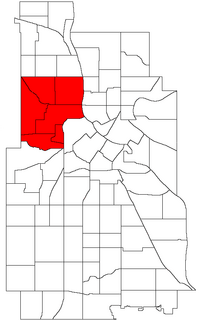Near North, Minneapolis facts for kids
Quick facts for kids
Near North
|
|
|---|---|
|
Community
|
|

Location of Near North within the U.S. city of Minneapolis
|
|
| Country | United States |
| State | Minnesota |
| County | Hennepin |
| City | Minneapolis |
| Founded | 1849 |
| City Council Wards | 4, 5 |
| Neighborhoods | |
| Area | |
| • Total | 4.602 sq mi (11.92 km2) |
| Population
(2020)
|
|
| • Total | 35,013 |
| • Density | 7,608.2/sq mi (2,937.5/km2) |
| Time zone | UTC-6 (CST) |
| • Summer (DST) | UTC-5 (CDT) |
| ZIP code |
55405, 55411
|
| Area code(s) | 612 |
Near North is a community in Minneapolis, a large city in Minnesota, USA. It is located northwest of the city's downtown area. People often refer to Near North and the nearby community of Camden together as "North Minneapolis."
In the early 1900s, Near North was a main center for Jewish people in the city. Since then, it has also become home to a large African American population. It is a very important place for Black culture, homes, and businesses.
Contents
A Look Back: History of Near North
The Near North community in Minneapolis has had a significant African American presence since the early 1900s. It has its own businesses, groups, and culture. Even today, it remains a central place for African American life in Minnesota.
A Welcoming Place for Many
Minneapolis' Near North Side has often been a safe place for groups who faced challenges. This was mainly because housing was affordable and it was close to downtown. In the early 1900s, many Jewish people in the Twin Cities lived in Near North. They settled especially along Plymouth Avenue and what is now Olson Memorial Highway.
Moving to North Minneapolis
In the past, rules in real estate agreements limited where Black people could live in Minneapolis. During World War I, many Black families started moving from older neighborhoods like Seven Corners and the South Side to the North Side.
The Sumner Field public housing project was finished in 1938. It was a place where people lived in separate areas based on race. However, the white Jewish and Black residents generally got along well.
Jewish Life in North Minneapolis
By 1936, over 16,000 Jewish people lived in Minneapolis. About 70% of them lived on the North Side. The Jewish community in North Minneapolis had a very active social and cultural life. They had groups called landsmanschaften (groups for people from the same hometown).
They also shopped together at many local businesses. These included kosher butcher shops, fish markets, grocery stores, bakeries, clothing stores, barber shops, and restaurants. These businesses grew along Sixth Avenue North and later Plymouth Avenue. This community also had Hebrew schools, synagogues (places of worship), and social groups.
Support for the African American Community
When Black people arrived in the Twin Cities, they often did not have access to the same community services as white people. Because of this, Black churches, social groups, and barber and beauty shops became very important. They provided much-needed support.
One such place was the Phyllis Wheatley Settlement House. It opened in 1924 as a recreation center for African American children. Ethel Ray Nance, an African American activist and writer, was also involved with the Wheatley House.
In 2018, the Minneapolis African American Heritage Museum and Gallery opened. It is located at Penn Avenue and Plymouth Avenue North. Its main goal is to protect the history of African Americans in Minnesota. It also aims to show off the community's many achievements.
Where is Near North?
Near North is bordered by several important landmarks. To the west, it reaches the Minneapolis city limits at Xerxes Avenue. Lowry Avenue is its northern border. The Mississippi River and I-94 are to the east. Bassetts Creek and Plymouth Avenue form its southern boundary.
Most of Near North is in Ward 5, which is represented by city council member Jeremiah Ellison. A small part in the northwest is in Ward 4, represented by LaTrisha Vetaw. These council members help make decisions for the city.
How Many People Live Here?
The number of people living in Near North has stayed about the same since 1980. Currently, just over 35,000 people call Near North home.
| Historical population | |||
|---|---|---|---|
| Census | Pop. | %± | |
| 1980 | 33,721 | — | |
| 1990 | 35,225 | 4.5% | |
| 2000 | 35,632 | 1.2% | |
| 2010 | 31,192 | −12.5% | |
| 2020 | 35,013 | 12.2% | |
In 2020, the community's population was made up of different groups:
- About 51% (17,987 people) were Black.
- About 22% (7,804 people) were White.
- About 10% (3,632 people) were Hispanic or Latino.
- About 8% (2,870 people) were Asian.
- About 1% (456 people) were Native American.
- About 7% (2,365 people) were of two or more races.
Also, about 20% (6,916 people) of the residents were born in another country. When it comes to education, about 19% of adults have less than a high school diploma. This is higher than the city average of 9%. About 24% have a bachelor's degree or more, which is lower than the city average of 53.5%.
Neighborhoods in Near North
The Near North community is made up of six smaller neighborhoods:

